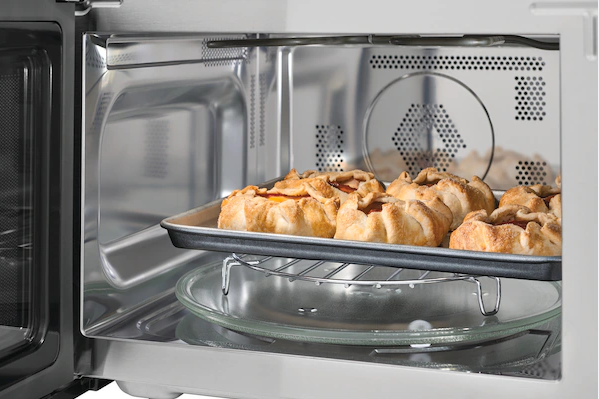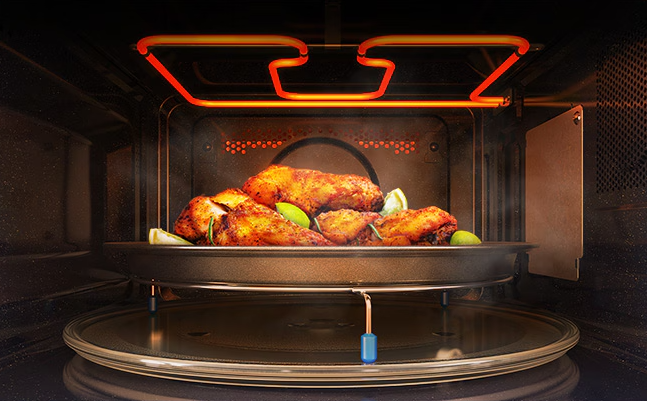Ever found yourself staring at your microwave, a simple plate of leftovers in hand, and wondering, “Is this thing actually safe?” You’re not alone. The question of whether the Is Microwave Oven Safe For Health has been a hot topic for decades, fueled by myths and misinformation. Here at Microwave Oven Top, we believe in empowering you with facts, not fear. So, let’s pull back the curtain, debunk the myths, and uncover the science-backed truth about your trusty kitchen sidekick.
The short answer? Yes, when used correctly, microwave ovens are a perfectly safe and incredibly efficient way to cook and reheat food. But the “how” and “why” are what truly matter. This guide will walk you through everything you need to know, from the science of microwave radiation to the real dangers you should be aware of (spoiler: it’s probably not what you think!).
How Do Microwaves Actually Cook Your Food?
Before we tackle the safety concerns, let’s get a quick refresher on how this magic box works. It’s not powered by tiny dragons, but by something called a magnetron.
- The magnetron generates microwaves, which are a type of electromagnetic wave, just like radio waves or visible light.
- These waves flood the inside of the oven and are particularly good at being absorbed by water, fats, and sugars.
- When the water molecules in your food absorb these microwaves, they start to vibrate rapidly.
- This vibration creates friction, which in turn produces heat.
Think of it like rubbing your hands together on a cold day to warm them up. The microwave makes the water molecules in your food do the same thing, cooking it from the inside out. It’s a remarkably efficient process that heats the food directly, not the air around it.
The Big Question: What About Microwave Radiation?
This is the heart of the matter for most people. The word “radiation” often conjures up scary images of nuclear power plants or X-rays. However, it’s crucial to understand that not all radiation is created equal.
Non-Ionizing vs. Ionizing Radiation: The Key Difference
The key to understanding microwave safety lies in the difference between non-ionizing and ionizing radiation.
- Ionizing Radiation: This is the high-energy, potentially harmful type. It includes X-rays, gamma rays, and ultraviolet (UV) light. This type of radiation has enough energy to knock electrons out of atoms, which can damage DNA and lead to health problems like cancer.
- Non-Ionizing Radiation: This is the low-energy type. Microwaves fall squarely into this category, alongside radio waves, visible light, and infrared. This radiation has enough energy to make molecules vibrate (which is how it heats food), but not enough to alter them chemically or damage your DNA.
Expert Quote: “The fear around microwave ‘radiation’ is a classic case of misunderstanding terminology,” says Dr. Alisha Sharma, a food scientist and safety consultant. “The energy from a microwave is just strong enough to excite water molecules. It cannot make your food radioactive or change its molecular structure in a way that would be harmful to your health. It’s fundamentally different from the radiation used in medical imaging.”

Infographic showing how microwave ovens are safe for health by using non-ionizing radiation to heat food molecules.
Built-in Safety: How Your Microwave Protects You
Microwave oven manufacturers are required by law (like regulations from the FDA in the United States) to build in several safety features to ensure that you are protected.
- The Metal Box: The interior of your microwave acts as a Faraday cage, preventing the microwaves from escaping.
- The Mesh Screen: That black grid on the glass door? The holes are too small for microwaves to pass through, but large enough for you to see your food.
- Automatic Shut-off: The moment you open the door, the magnetron stops producing microwaves instantly.
These mechanisms are extremely effective. The amount of radiation that could potentially leak from a new, undamaged microwave is far below the level permitted by international safety standards and is generally undetectable.
Is Microwave Oven Safe For Health Regarding Nutrients?
Another common concern is that microwaving zaps the nutrients right out of your food. The truth is a bit more nuanced and, frankly, quite positive for the microwave.
All cooking methods—boiling, steaming, frying, baking—reduce the nutrient content of food to some degree, especially water-soluble vitamins like Vitamin C and B vitamins. The main culprits are heat and time.
Because microwave cooking is incredibly fast and often uses less water than methods like boiling, it can actually be one of the best cooking methods for preserving nutrients. Studies have shown that microwaving vegetables like broccoli retains more of its vitamin C than boiling it. The shorter the cooking time, the more nutrients are preserved.
The Real Danger: It’s Not the Oven, It’s the Container
If the radiation isn’t a concern and it’s good at preserving nutrients, then where is the risk? The most significant and real health risk associated with microwaving comes from using improper containers.
Heating certain types of plastics can cause chemicals, such as BPA (bisphenol A) and phthalates, to leach into your food. These chemicals are known as endocrine disruptors and have been linked to various health issues.
What to Use: Microwave-Safe Containers
- Glass and Ceramic: These are your safest bets. Make sure they don’t have any metallic paint or trim.
- Microwave-Safe Plastics: Look for a “Microwave Safe” label or symbol (often a dish with wavy lines). These plastics are designed to withstand microwave heat without leaching chemicals.
- Wax Paper and Parchment Paper: Great for covering food to prevent splatters.
What to Avoid: The No-Go List
- Single-Use Plastics: Yogurt cups, takeout containers, margarine tubs, and water bottles are not designed for the heat of a microwave.
- Styrofoam: Can melt and release harmful chemicals.
- Metal: This includes aluminum foil, metal-trimmed plates, and stainless steel travel mugs. Metal reflects microwaves, which can cause sparks and even damage your oven.
- Brown Paper Bags: They can be a fire hazard.
Expert Quote: “I always tell my clients to focus on what they put in the microwave, not the microwave itself,” notes Michael Chen, a registered dietitian and nutritionist. “Investing in a good set of glass containers is one of the best things you can do for your health and peace of mind. It completely eliminates the risk of chemical leaching and ensures your food is heated cleanly and safely.”

A clear visual comparison of safe microwave containers like glass and ceramic versus unsafe ones like plastic takeout boxes and styrofoam.
Top 5 Microwave Safety Tips for Everyday Use
To get the most out of your microwave and ensure you’re always using it safely, just follow these simple rules:
- Check for Damage: Don’t use a microwave if the door doesn’t close properly, is bent, or if the seal is damaged.
- Use Microwave-Safe Containers Only: When in doubt, transfer food to a glass or ceramic dish.
- Cover Your Food: Use a microwave-safe lid, paper towel, or wax paper to prevent splatters and ensure even cooking. This also helps retain moisture.
- Don’t Run It Empty: Operating a microwave with nothing inside can seriously damage the magnetron, as the unabsorbed energy is reflected back into it.
- Avoid Superheating Water: Microwaving plain water in a clean cup can sometimes heat it beyond its boiling point without the appearance of bubbles. Bumping or adding something to the cup (like a tea bag) can cause it to erupt violently. To be safe, add a wooden stirrer or a tea bag before heating.
Conclusion: Use Your Microwave with Confidence
So, is microwave oven safe for health? The overwhelming scientific consensus is a resounding yes. The radiation they use is non-ionizing and harmless, they are excellent at preserving nutrients, and they are built with robust safety features. The real key to microwave safety lies in your hands—by using the right containers and following basic operating guidelines.
Now that the myths are busted, you can embrace the convenience and efficiency of your microwave with confidence. Go ahead and reheat those leftovers, steam some vegetables for a healthy side dish, or try one of our [internal link to recipes] creative microwave recipes. Your kitchen’s most misunderstood appliance is ready to help.
Frequently Asked Questions (FAQ)
1. Can Microwave Ovens cause cancer?
No. Microwaves use non-ionizing radiation, which does not have enough energy to damage DNA and cause cancer. This is a common myth with no scientific backing. Reputable organizations like the World Health Organization and the American Cancer Society have found no evidence linking microwave use to cancer.
2. Is it bad to stand in front of a microwave while it’s running?
No. Modern microwaves are built with excellent shielding that keeps radiation from escaping. The tiny amount that might leak is well below safety limits and is not considered harmful. You would receive far more exposure to electromagnetic fields from other everyday devices.
3. Does microwaving food make it radioactive?
Absolutely not. Microwaves heat food by making water molecules vibrate. They do not leave any kind of “radiation” behind in the food, and they cannot make it radioactive. Once the microwave is off, the microwaves are gone.
4. What happens if I accidentally microwave metal?
Microwaving metal can cause sparks, a phenomenon called “arcing.” This happens because the metal reflects the microwaves, causing a buildup of electrical charge. This can damage the inside of your microwave and is a potential fire hazard. Always remove foil and use non-metallic dishes.
5. Are old or damaged microwaves dangerous?
A microwave with a broken or poorly sealed door could potentially leak higher levels of microwaves. While still unlikely to be at a level that causes immediate harm, it’s best to err on the side of caution. If your microwave’s door is bent, damaged, or doesn’t close securely, it’s time to replace it.